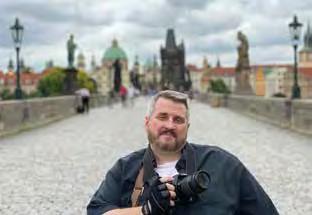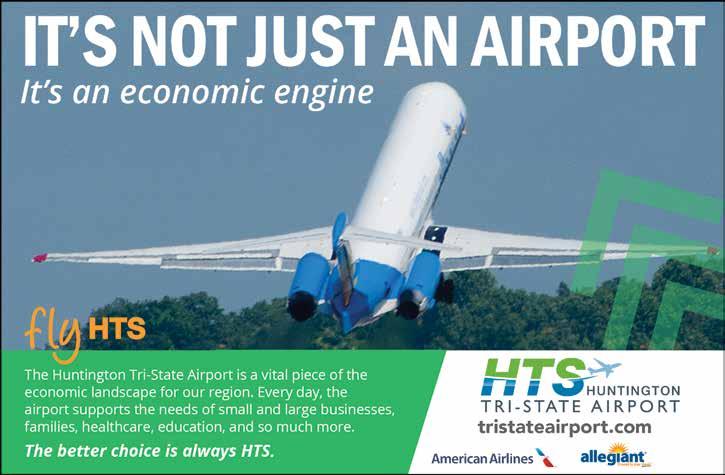
69 minute read
CATCHING UP WITH THE PRESIDENT
Catching up with President Gilbert
1. 2.
Advertisement
3. 4.
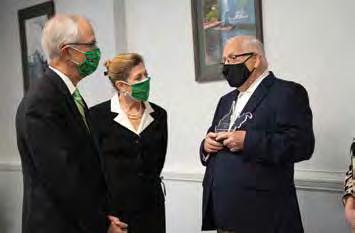
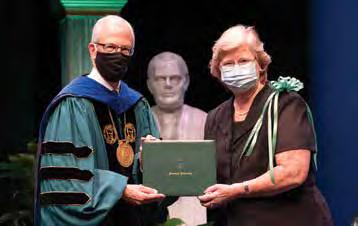
5. 6.
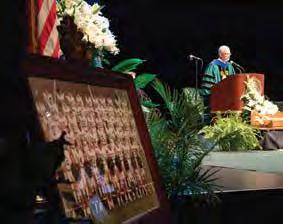
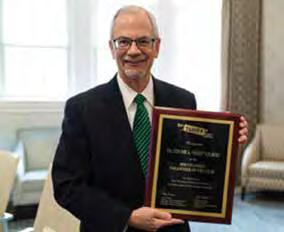
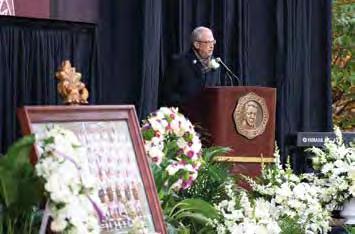
1. President Gilbert participated in presenting the John Deaver Drinko Academy 2020 Community Service Award to Howard Osborn (right) Nov. 5 for his extensive work on the history of Wayne County, West Virginia. They are pictured with Dr. Monserrat Miller (center), executive director of the Drinko Academy.
2. President Gilbert gives remarks at the rededication of Marshall Football Memorial Nov. 10. The memorial sculpture, designed by Vernon Howell, has been restored relocated to the Huntington campus between the Marshall Rec Center and the Sorrell Maintenance Building. The statue was originally dedicated in 1971 and housed at the Pi Kappa Alpha (ΠΚΑ) house on 5th Avenue.
3. President Gilbert addresses the family members and others gathered for the presentation of posthumous degrees for the students who died in plane crash Nov. 13. Where possible, a family member accepted the degree, but Marshall students and staff members filled in to accept diplomas for those whose family members could not be present.
4. President Gilbert presents the posthumous degree diploma for David DeBord to DeBord’s sister, Jane DeBord Hammelman, at the ceremony Nov. 13.
5. President Gilbert speaks at the 50th annual memorial service for the victims of the plane crash Nov. 14.
6. President Gilbert received the Huntington Regional Chamber of Commerce’s Volunteer of the Year award at its annual volunteer event Jan. 29.
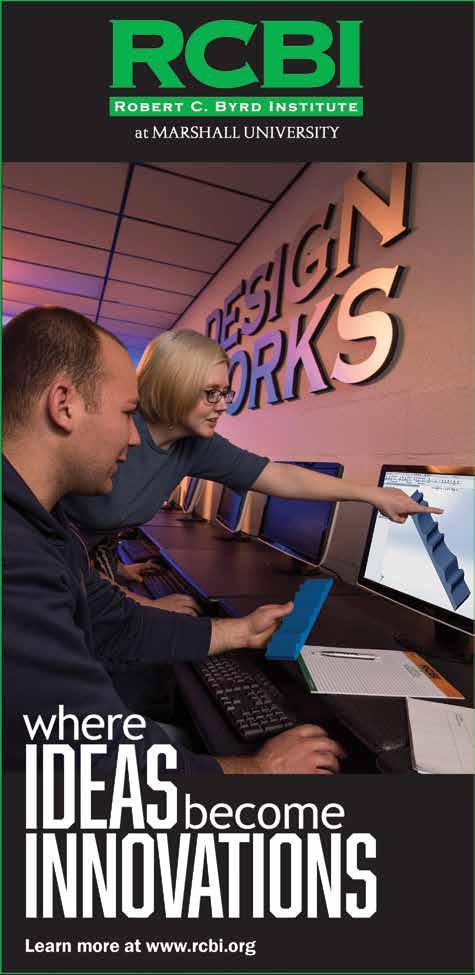
HUNTINGTON & MARSHALL
As Huntington celebrates its 150th anniversary, we take a look at how the city and university are inextricably linked.
PHOTO BY BRYAN CHAMBERS.
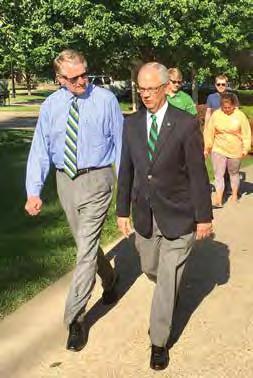
By James E. Casto
Photos by Rick Lee

HUNTINGTON
Marshall University traces its origins to a school is celebrating the 150th anniversary of & MARSHALL conducted for the children of local farmers in a its birth. small log church on the knoll where Old Main Over the decades, the histories of Marshall and now stands. Founded in 1837, the school was already Huntington have been inextricably intertwined and the more than 30 years old before two have proven to be partners rail tycoon Collis P. Huntington in the growth and development picked out a riverfront tract as the of the community and region. site of a new city named for him. “Marshall is the heartbeat of
Huntington was one of Huntington,” says Huntington the builders of the great Mayor Steve Williams. Transcontinental Railroad. On Marshall President Jerome May 10, 1869, at Promontory Gilbert agrees, and says when he Point, Utah, a golden spike was arrived as the school’s new presidriven to mark the completion dent in 2016, he found a “town of the long-dreamed-of railroad. and gown” relationship between
Only months later, on Nov. 23 the university and the people of of that year, Huntington launched Huntington to be unlike any he another railroad adventure when had ever seen elsewhere. he purchased the all-but-bankrupt “I’ve been in towns where Chesapeake & Ohio Railway there was quite a bit of tension and started work on extend- between the town and the uniing its tracks from Richmond, versity,” Gilbert said. “People Virginia, westward across south- The city of Huntington became the official namesake would say things like ‘What are ern West Virginia to the Ohio of railroad tycoon Collis P. Huntington in 1871. all these students doing here, River. Seeking a getting in our way good spot to transfer passengers and cargo between the C&O and the riverboats that plied the Ohio, Huntington purchased 21 acres of farmland on the Ohio just downstream from the village of Guyandotte. There he set about building a town that would be COURTESY MARSHALL UNIVERSITY SPECIAL COLLECTIONS. PHOTO CIRCA 1880S. all the time?’ That’s not the case here in Huntington. We have a community that’s fully integrated with the university. The resiliency and optimism found here are inspiring.” Williams and Gilbert agree that the Marshall plane crash pulled the school and the comhome to his railroad. munity together as On Feb. 27, 1871, never before. the West Virginia The 1970 crash of Legislature approved a chartered jet at Trian act officially in- Old Main began as a two-story brick building in 1839. A second addition was State Airport claimed corporating the rail tycoon’s new town. completed in 1857-58 and joined on the west end of the structure. In 1870, the same year the city of Huntington was incorporated, a third section that contained a large bell tower was added on the west end of the 1857 building. The 1870 the lives of all 75 aboard — Marshall This year, the city addition remains the oldest section surviving of this original set of buildings. football players, their

(Opposite) Huntington Mayor Steve Williams and Marshall President Jerome A. Gilbert take a walking tour through the university’s Huntington campus as they discuss student safety at the school and in the community.
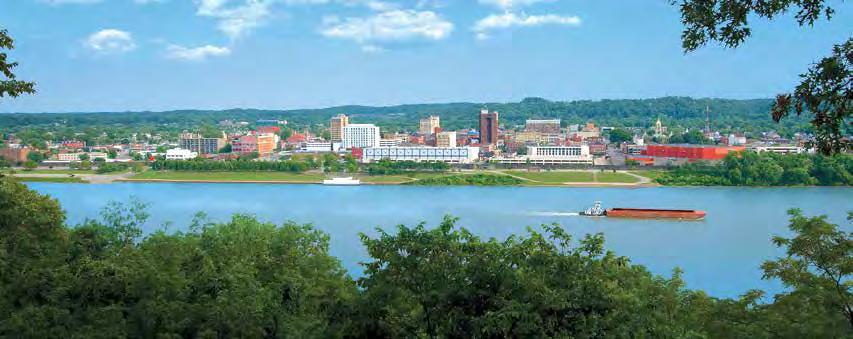
Traditionally, Marshall’s campus consisted of a few blocks on Hal Greer Boulevard, but the university’s growth has dramatically changed the city’s skyline with a multitude of new buildings.
coaches, the flight crew and a number of boosters who were traveling with the team. Many of those fans were among Huntington’s finest leaders. In the wake of the crash, there were calls for Marshall to drop football. But both the university and the community persevered. The comeback of Marshall football is legendary and the rebuilding of Huntington proved to be equally remarkable, with a new generation of leaders stepping forward. “The individuals in that new generation were inextricably connected to Huntington and Marshall,” Williams said. “I’m talking about people like Mike Perry and Marshall Reynolds, who worked tirelessly and rallied many others to the cause. Look how different Marshall and Huntington are today.”
For decades, Marshall was strictly a small teachers’ college tucked away in a sleepy little town. Its transformation started when it gained university status, but what really sealed the deal came in 1978 when the medical school welcomed its first class of future doctors. Since its birth, the Joan C. Edwards School of Medicine has recognized twin obligations. “We exist not only to train a medical workforce but also to contribute to the health and wellness of the region,” said Joseph L. Shapiro, M.D., the med school’s dean since 2012. The school’s scope has steadily increased over the years and Marshall Health, the school’s faculty practice plan, has grown to meet that challenge. Today, it’s one of the largest employers in West Virginia, ranking 35th on the state’s list of top employers. “We operate at five hub locations where our clinical
The medical school trains future doctors, but also contributes to the health and wellness of the region.

— President Jerome A. Gilbert
faculty members practice, along with 40 clinics located in 13 counties in the region, with a total of 250 health care providers and more than 1,400 employees,” said Marshall Health CEO Beth Hammers. “That’s not counting an additional 450 basic and clinical faculty, researchers, administrators and other support staff employed by the School of Medicine.”
At the same time, the med school has sparked multi-million-dollar expansions at Cabell Huntington Hospital, St. Mary’s Medical Center and the VA Regional Medical Center.
The impact of the medical school can only be described as immense.
“The med school has changed the direction of the university and the community,” Gilbert said. “Today, the med school has enabled us to become a research university, making it possible to tap the necessary grant funds to finance that all-important research. And, thanks to the med school, people needing sophisticated medical treatment no longer have to go to Columbus or Cleveland for it. They can get that care right here. Huntington has grown into a regional powerhouse in health care, with medical facilities and services that would be the envy of many communities far larger in size.”
For much of Marshall’s history its campus consisted of a few blocks on Hal Greer Boulevard. But the university’s growth has dramatically changed the city’s skyline with a multitude of new buildings. The university’s footprint
HUNTINGTON
extends along Hal Greer Boulevard with & MARSHALL the medical school, the Forensic Science Center and the School of Pharmacy. It even has a presence downtown with the Robert C. Byrd Institute and the Visual Arts Center. And soon the College of Business will occupy a handsome new building downtown.
Busy Hal Greer Boulevard is the epicenter of Huntington’s medical infrastructure — and the gateway from Interstate 64 to the Huntington campus and the city’s downtown. With that in mind, an effort is underway to improve the boulevard so that it becomes safer for motorists, pedestrians and bicyclists and more conducive to redevelopment.
“Upgrades to the Hal Greer Boulevard corridor are very important to Marshall University, particularly as our health sciences footprint continues to grow in the Fairfield area,” said Gilbert. “Safety is our paramount concern. A big part of the problem is that people drive too fast through there.”
“We’re proud to partner with the city, the hospital, and
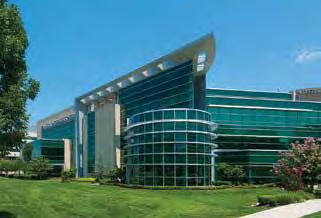
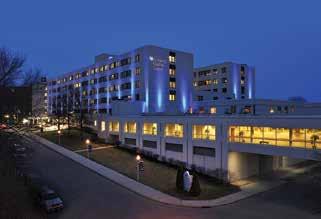
Marshall University has sparked mulit-million-dollar expansions at both Cabell Huntington Hospital and St. Mary’s Medical Center.
Marshall University continues to grow — as does its Huntington campus — while it positively impacts the city that it calls home.
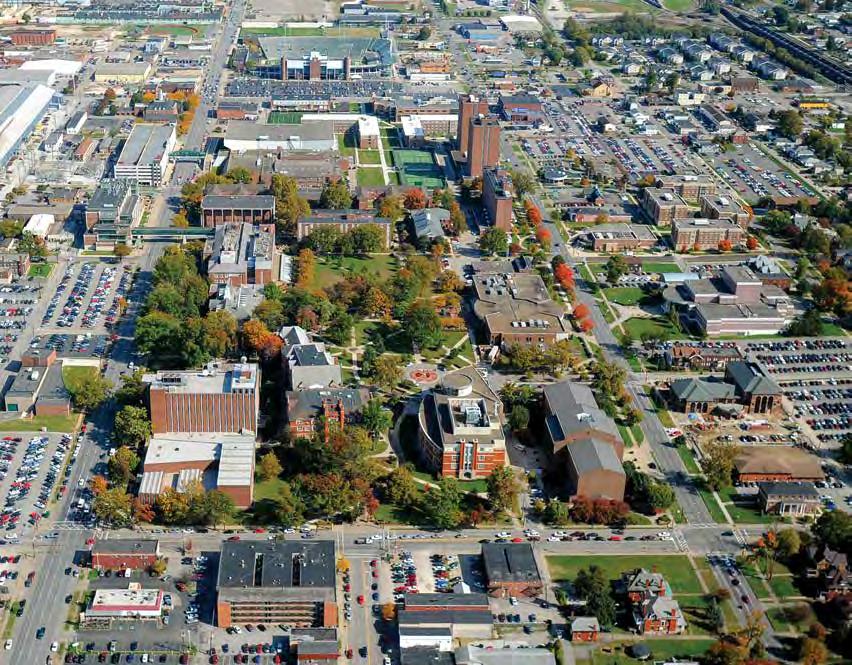
Fairfield’s residents and businesses to improve the quality of life in the neighborhood,” he said. “Creating a safer Hal Greer Boulevard is an important step in that direction.”
Marshall is also partnering with the city on an ambitious revitalization plan for the city’s blighted Highlawn neighborhood. Once a busy industrial center, Highlawn is now mostly composed of abandoned buildings and weed-infested vacant lots.
“Think about it,” said Williams. “We have a burgeoning research university, a growing medical center just down the street and nearly 100 acres of former industrial property that’s ripe for development. If we don’t take full advantage of that we will miss a golden opportunity.”
The centerpiece of the Highlawn plan is the former ACF Industries plant. Founded at the city’s birth in 1871, the plant long manufactured and repaired rail cars. It has sat idle for the past 20 years. The city acquired the 37-acre property earlier this year.
“The old ACF plant will never again return to full-scale manufacturing. It’s just not in the cards,” said Williams. “But it’s a huge chunk of land adjacent to the Marshall campus and an ideal spot for a mixed-use development.”
The vision for the Highlawn plan includes a set of distinct development zones, each anchored by a major use, such as high-tech research and production facilities, a hotel and conference center, signature public spaces and even a long-proposed Marshall baseball stadium.
“Work on the stadium has been temporarily halted by the COVID-19 pandemic,” Gilbert said. “But we need to use that delay to do some redesign work. Frankly, the original design for the stadium was too expensive, so we have to go back and scale it down a bit.”
— Mayor Steve Williams
Another important partnership between the city and Marshall is an aggressive effort to counter the community’s addiction problem. The increased use of opioids, alcohol and other substances culminated in a perfect storm that hit Huntington and southern West Virginia particularly hard.
Working together, the city, the university, the med school, Marshall Health, the hospitals and the CabellHuntington Health Department have been able to create some truly revolutionary programs which are recording impressive success — a decline in overdoses, an increase in referrals to treatment and a reduction in drug-related crime.
“It’s our hope that our efforts lead to long-term recovery for individuals in Huntington and elsewhere in West Virginia and help establish a model for other communities struggling with addiction,” Gilbert said.
“In conclusion, let me say this,” Williams said. “When there’s a problem or a need in our community, more often than not the answers come from Marshall and the brilliant, dedicated people found there. Make no mistake about it, there’s no such thing as an ivory tower at Marshall.”
James E. Casto is the retired associate editor of The Herald-Dispatch and the author of a number of books on local and regional history.
MOUNTAIN STAGE
concert at Joan C. Edwards Stadium to celebrate Huntington’s 150th anniversary
HUNTINGTON & MARSHALL
In conjunction with the Marshall Artists Series and the City of Huntington, Mountain Stage, the live radio program produced by West Virginia Public Broadcasting, will host a sesquicentennialthemed concert on Friday, April 16, at 7:30 p.m. The rain-or-shine event will take place at Joan C. Edwards Stadium. All local, state and federal safety guidelines will be followed.
“The Marshall Artists Series is honored to be part of Huntington’s 150th Anniversary celebration,” said Penny Watkins, executive director of the Marshall Artists Series. “As an 84-year-old entity at Marshall, our history is intertwined with Huntington’s history. And we are proud to be part of that legacy.”
“We are thrilled to partner with Mountain Stage and the Marshall Artists Series as we celebrate a benchmark year in our community’s history,” said Mayor Steve Williams. “Mountain Stage has always delivered a quality product that features musical performers who reflect our innovative and imaginative spirit in West Virginia and especially here in Huntington. There will be no better time for Huntington to be cast in the world spotlight than during our 150th anniversary year.”
For more than 30 years, Mountain Stage has been the home of live music on public radio. Hosted by Larry Groce, the program is produced in West Virginia and distributed worldwide by NPR Music.
General admission tickets for the event are $60, with fees and taxes included in the price. Tickets will be available soon. Performing artists will be announced at a later date. For more information go to www.mountainstage.org.
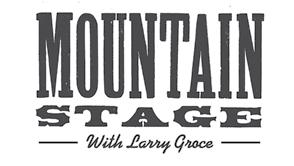
Helping Huntington
Meet some of the university’s alumni who have played a vital role in Huntington’s growth and success over the years.
Ever since Marshall University was founded in 1837 as a small teachers’ college, it has been producing graduates who have played a vital role in the growth and success of Huntington. In fact, Marshall was already in its 34th year when Collis P. Huntington established his namesake city in 1871. In the decades that followed, alumni from the school have gone on to become prosperous business owners, respected politicians, professional athletes, major figures in the arts, leaders in social justice and much more. And while it is impossible to recognize all the alumni who have made significant contributions to Huntington in the last 150 years, these are some of the individuals who have displayed exemplary leadership in the city’s more recent history. The following list is in alphabetical order.
By Jack Houvouras & James E. Casto
Paul Ambrose
Paul Ambrose was well on his way to becoming the youngest U.S. surgeon general in history when his life was cut short during the attacks of 9/11. Ambrose, 32, was flying to Los Angeles to attend a conference on youth obesity prevention when his plane crashed into the Pentagon. A champion for improving public health care for all Americans, his legacy lives on in the dozens of scholarships and programs that bear his name in around the nation, including Huntington’s Paul Ambrose Trail for Health (PATH) in Huntington.
Bill Bissett
A proud Marshall alumnus and former chief of staff to Marshall President Stephen J. Kopp, Bissett moved back to his hometown of Huntington four years ago to run the Huntington Regional Chamber of Commerce. He became involved in numerous boards, organizations and charities, usually connected to some facet of improving education in our region. As a seasoned public relations practitioner, he has worked tirelessly to promote Huntington as a great place to live, work and raise a family.
Troy Brown
The undersized football player from Blackville, South Carolina, made a name for himself playing wide receiver and returning punts for the Thundering Herd before going on to garner three Super Bowl rings with the New England Patriots. Today he calls Huntington home and gives back to the community in numerous ways, including the annual Bartrum and Brown Football Camp for local youth.
Cathy Burns
She was the first female president of the Huntington Regional Chamber of Commerce. Before that she was the highly-respected executive director of the Huntington Municipal Development Authority, where she played a major role in the development of KineticPark and the recruitment of the Amazon Customer Service Center. Just some of the other projects Burns was involved with include the development of Pullman Square, creation of the Central City Market, and the certification of the historic district for downtown Huntington. Her work has created hundreds of jobs, infused the city with millions in tax dollars, and helped preserve and restore some of Huntington’s most beautiful buildings.
HUNTINGTON & MARSHALL
Robert C. Byrd
Early in his career, the late Robert C. Byrd, the longest serving senator in history, briefly attended Marshall College. Years later, he decided to complete his bachelor’s degree, graduating from Marshall in 1994. As a powerful U.S. senator, he channeled tens of millions of dollars to Huntington projects. The Robert C. Byrd Bridge that links Huntington and Ohio, the Robert C. Byrd Institute, MU’s Robert C. Byrd Biotechnology Science Center and the Erma O. Byrd Clinical Center are just part of his impressive legacy.
Chuck Chambers
Robert Charles Chambers, better known as Chuck, earned his bachelor’s degree at Marshall University and his law degree from WVU School of Law. He was a member of the West Virginia House of Delegates from 1978 to 1996, serving as house speaker for 10 years, from 1986 to 1996, the longest term for any speaker in the state’s history. In 1997, President Bill Clinton successfully nominated him to a seat on the U.S. District Court for the Southern District of West Virginia.
Phil Cline
Retired businessman Phil Cline is a former member of Huntington City Council and past member of the Cabell Huntington Hospital board of directors. And his record of public service to the community is more than matched by his generosity. In 2008, he donated $250,000 to the Emogene Dolin Hospice House for installation of a chapel, and in 2010 the Phil Cline Family YMCA was named for him when his generous gift made the facility’s construction possible.
Verna Gibson
Verna Gibson started her career in retail working part time in downtown Huntington before moving to Columbus, Ohio, and impressing The Limited’s CEO Les Wexner. Gibson rose through the ranks and in 1985 became the CEO of The Limited Stores, making her the first female CEO of a Fortune 500 company. Gibson, who now sits on the
boards for Chico’s and White House Black Market, was responsible for securing many of the retail businesses that located in downtown Huntington’s Pullman Square.
Beth L. Hammers
As CEO of Marshall Health, Hammers has worked alongside School of Medicine and community leaders to expand the footprint of Marshall’s health sciences campus and bring new service lines to the region. From Marshall’s flagship medical center to the Erma Ora Byrd Clinical Center and Project Hope for Women and Children, Hammers has been a part of building or renovating numerous outpatient clinics, education spaces and addiction recovery centers. Today, Marshall Health is the largest and most comprehensive health care provider group in the region with facilities and services in more than 40 locations throughout the Tri-State.
David Harris
David Harris has a long history of community service. He chairs the Southwest Community Action Council’s
© THE HERALD-DISPATCH, USED BY PERMISSION. board of directors and is a member of the Huntington Police Department Civil Service Commission, a board member with the Cabell/Huntington NAACP and a member of the Carter G. Woodson Memorial Foundation. He’s a member of the board of directors and coaches Little League at the A.D. Lewis Community Center, where he played as a youngster. Little wonder there’s a Huntington street named for him.
Jeff Hoops
Jeff Hoops is founder of the Hoops Family Foundation that has built projects around the world. In Huntington, the foundation funded construction of the Hoops Family Children’s Hospital at Cabell Huntington Hospital and the Hoops Family Soccer Stadium at Marshall University. Currently he’s overseeing the transformation of the longabandoned Morris Memorial Hospital for Crippled Children in Milton into an elegant resort with a 100-room hotel, a nine-hole golf course and other facilities.
THE ALUMNA WHO SHOULD HAVE BEEN: Dr. Betty Jane Cleckley
Aug. 15, 1931-Jan. 8 2021
When Betty Cleckley graduated from Douglass, the city’s Black high school, she couldn’t go to Marshall because it was still segregated. So, she left Huntington to earn degrees from Marquette, Smith College and Brandeis, as well as postgraduate work at Harvard. In 1989, she came back to Huntington to become Marshall’s first vice president of multicultural affairs, serving 18 years in that post.
Cleckley passed away Jan. 8.
“Dr. Cleckley is being remembered on our campus and across the nation as a lifelong advocate for social justice and a voice for those who often felt unable to speak for themselves,” said Marshall President Jerome A. Gilbert. “While I never had the pleasure of meeting her, Dr. Cleckley was certainly an iconic force at Marshall, loved and respected by generations of colleagues and students. Her legacy and foundational work continue today at Marshall, where we value each person for who they are and welcome everyone as an important member of our community.”
Cleckley received a Bachelor of Science degree from Marquette University in Milwaukee, Wisconsin; a Master of Social Science degree from Smith College in Northampton, Massachusetts; a Ph.D. degree from Brandeis University in Waltham, Massachusetts; and a postdoctoral certificate in higher education management from Harvard University, Cambridge, Massachusetts.
She served over 31 years in administrative and teaching positions in the health and higher education fields:
• Director of the Black College
Initiative at the Agency on Alcohol,
Drug Abuse, and Mental Health
Administration in Washington,
D.C.; • Associate dean and associate professor at the School of Social Work at the University of Tennessee,
Knoxville; • Assistant vice president of academic affairs, interim vice president of institutional advancement, executive assistant to the president and coordinator of centers of excellence at Meharry Medical College,
Nashville, Tennessee; • Vice president for multicultural
Sean Hornbuckle
Financial services broker Sean Hornbuckle grew up on Daulton Avenue in Huntington’s Fairfield neighborhood. Today, he recalls his parents telling him nothing was impossible if you worked hard enough to achieve it. That willingness to work hard fueled his election as student body president at Marshall University and, in 2014, won him a seat in the West Virginia House of Delegates, where he’s focused on the needs of working families, small business owners, economic development and, of course, Marshall.
Brandi Jacobs-Jones
The current Chief of Staff and Senior Vice President for Operations for Marshall, Jacobs-Jones previously served three mayors as the city’s director of administration and finance. Before working for the city, she served four years as the development officer for Ebenezer Medical Outreach Inc. in Huntington, which offers free or affordable health care to the Fairfield West community HUNTINGTON & MARSHALL and the surrounding region. She is also a former member of the Huntington City Council and has served on the board of directors of the Huntington Museum of Art, Ronald McDonald House, the Salvation Army and more.
Jim Justice
Jim Justice, the billionaire businessman with a big heart, was a tall, lanky golfer at Marshall before taking over the family coal business. Today he is most well known as the owner of the Greenbrier Resort and the governor of West Virginia, where has supported numerous initiatives in Huntington including financing the city’s purchase of the ACF property, funding the local Thunder Cloud highspeed broadband internet project, assisting in the redesign of Hal Greer Boulevard and more.
Margaret Mary Lane
As former executive director of the Huntington Museum of Art and a former Huntington city manager,
affairs and international programs, Marshall University, Huntington, West Virginia.
Cleckley was active in civic and professional organizations, and served on national and state boards, such as the Defense Advisory Committee for Women in the Services (DACOWITS) and the State of West Virginia Human Rights Commission. She served on the Martin Luther King, Jr. State of West Virginia Holiday Commission, the Board of Directors of the Keith-Albee Performing Arts Center, Friends of West Virginia Public Broadcasting, Cabell Huntington Hospital Foundation Inc. Development Council Community Relations Committee, and the Center for Aging and Health Care in West Virginia Inc. (CAH); life member of the National Association for the Advancement of Colored People (NAACP), a longtime dedicated member of the American Public Health Association (APHA) and National Council of Negro Women Inc.
Awards she received included the Distinguished Alumna Award, by Marquette University Helen Way Klingler College of Arts and Sciences, April 2005; the Governor’s Living the Dream Award by the Governor of West Virginia, January 1998; The W.E.B. DuBois Higher Education Award by the National Alliance of Black School Educators (NABSE), November 2000; The West Virginia Civil Rights Award by the State of West Virginia Human Rights Commission, February 2003; and the Celebrate Women Award in Education by the West Virginia Women’s Commission, May 2003; the Marshall University John Marshall Award for Meritorious Service, January 1997; the West Virginia University Dr. Martin Luther King Jr. Achievement Award, January 2006. The Betty Jane Cleckley Minority Issues Research Award, established by the American Public Health Association, recognizes research on minority health issues, particularly among the elderly. She also co-edited “Strategies for Promoting Pluralism in Education and the Workplace,” published by the Greenwood Publishing Company in 1997. She spoke and wrote extensively in the areas of education, social justice and opportunities for African Americans and worked tirelessly to raise funds to establish the Harmony Institute at Marshall University.
Margaret Mary Lane has worked for decades to make Huntington a better place. In 2017, she was a key player in the successful effort that saw Huntington beat out 352 other towns to win the title of “America’s Best Community” and the $3 million grand prize that went with it – money now being used to help finance the city’s ambitious neighborhood redevelopment plans.
Bobby Nelson
Bobby Nelson became active in politics and public service at an early age and made numerous contributions to Huntington in his lifetime. He served as a delegate in the West Virginia Legislature from 1965-1970, as a state senator from 1971-1985 and two terms as Huntington mayor from 1986-1993. He sponsored legislation that led to the construction of the Cam Henderson Center and Joan C. Edwards Stadium and assisted in founding the West Virginia Autism Training Center. Nelson also founded the Carter G. Woodson Memorial Foundation and is credited with playing a major role in the development of programs to help the homeless in our region.
Bill Noe
Many readers may remember Bill Noe as Marshall’s swimming standout who set a number of school and Southern Conference records in the pool. But after years in the water, he took to the air as a pilot and later served as the president and COO of Netjets, the largest private jet fleet in the world. Since retiring from Netjets he has given back to Huntington in numerous ways. Today the Huntington YMCA pool is named in his honor, as is the Marshall’s new flight school.
A. Michael Perry
The Huntington native was a lawyer, banker and museum founder. He even found time to serve as interim president of Marshall University. He was one of Huntington’s greatest leaders who served on dozens of boards. His tireless dedication to his beloved hometown had a profound impact on business, education, tourism, sports, culture, arts and more. It can be easily argued that no one did more to help Huntington succeed in the last 100 years than Mike Perry.
Bob Plymale
Bob Plymale has represented the 5th District in the West Virginia Senate since 1992 and is associate vice president for economic development at the Marshall University Research Corporation. Over the years, he’s been a vigorous and effective supporter of Marshall University, the Joan C. Edwards School of Medicine and the public schools of Cabell and Wayne counties. He’s co-president of the Keith-Albee Performing Arts Center Inc., which is working to preserve and restore the grand old theater located in the heart of downtown Huntington.
Jan Rader
In 2017, the Marshall alumna became the state’s first professional female fire chief. That same year she was featured in the Oscar-nominated Netflix documentary “Heroin(e)” for her relentless and innovative work combating the opioid epidemic in Huntington. In 2018, she was named to the TIME 100 — a list of the 100 most influential people in the world. Her work has saved countless lives and offered hope to anyone struggling with addiction.
Marie Redd
After working as a senior account representative at IBM for almost 20 years, Marie Redd switched gears, becoming a professor in the criminal justice department at Marshall University. In 1998, she was presented with an unexpected opportunity – to run for the West Virginia Senate. Redd won, becoming the first Black woman elected to the State Senate and the first female senator from Cabell County. She’s long been active in the Fairfield community, where the Marie Redd Senior Center is named in her honor.
ASSOCIATED PRESS
Rick Reed
Rick Reed was a star baseball pitcher at Huntington High and Marshall University before he was drafted by the Pittsburgh Pirates in 1986. He would bounce around the major leagues for the better part of 10 years before he found his stride with the New York Mets. There, he was an MLB All-Star in both 1998 and 2001. He returned to the Huntington area in 2005 to serve as the pitching coach of the Thundering Herd, and last year pledged $1 million for the construction of new baseball stadium that will benefit both the university and the entire community.
© THE HERALD-DISPATCH, USED BY PERMISSION.
Sylvia Ridgeway
Sylvia Ridgeway graduated from Douglass, the city’s former black high school, and later joined the faculty at Huntington High, where she taught English at the school to which she and other Black students had not been admitted during the segregation era. Long active in the NAACP at both the state and local level, she served as president of the Huntington-Cabell chapter for 16 years before stepping down earlier this year. In 2012, she was recognized for her years of service when The Herald-Dispatch named her as their “Citizen of the Year.”
Bob Shell
A successful international businessman whose company is headquartered in Huntington, Shell has worked quietly behind the scenes to improve the lives of young people throughout our community. A former chair of MU’s Board of Governors, he has sponsored numerous college scholarships and become a major contributor to a variety of worthwhile causes. In fact, in the last 30 years he and his family have donated money to more than 100 charities locally and around the world.
Brad D. Smith
The Kenova native and Marshall alum is currently the executive chairman of the board of directors and chairman of the board of directors at Nordstrom, yet he has still found time to give back to the region. His multimillion gifts to the university have resulted in a business incubator located in downtown Huntington, and coming-soon construction of the new Brad D. Smith Center of Business and Innovation, a large building complex to be located on the site of the former UpTowner Inn on 4th Avenue. His investments in the community should help spur economic development for years to come.
William “Bill” Smith
Bill Smith spent more than 40 years in Cabell County’s schools, starting out as a teacher at Huntington High School and retiring as superintendent in 2017. In that post, he had a tremendous positive impact on the county’s schools when he did something many thought was impossible — he convinced the voters to approve a $64.5 million bond issue that HUNTINGTON & MARSHALL financed the construction of three new middle schools and two new elementary schools. Today, he serves as a member of the MU’s board of governors.
Gary White
A longtime coal executive and respected leader throughout West Virginia, Gary White served as interim president of Marshall from January 2015 to January 2016, following the sudden death of President Stephen J. Kopp. Later, White was called on again for his business acumen and leadership when he oversaw the merger of Cabell Huntington Hospital and St. Mary’s Medical Center. He then served as interim CEO of the newly-formed Mountain Health Network.
Joe Williams
A former Huntington mayor and city councilman, Joe Williams spent years building his business, Basic Supply Co. Inc. Then, in 1991, he joined with three other concerned members of the city’s Black community to form Unlimited Future Inc., a non-profit aimed at helping other people learn how to successfully open their own businesses. In the years since, Unlimited Futures has helped launch more than 320 small businesses that are still operating today.
Steve Williams
The former Thundering Herd football standout has been a major civic leader in Huntington since he left Marshall. He was the youngest city manager in the history of Huntington, served several terms in the West Virginia Legislature, and is now in his third term as the city’s very popular mayor. Under his leadership Huntington has made major strides in combating an opioid epidemic. Mayor Williams also led a campaign in 2017 that resulted in Huntington being named “America’s Best Community” in a nationwide contest of 352 small communities.
Jack Houvouras is the editor of the Huntington Quarterly and publisher of Marshall Magazine. James E. Casto is the retired associate editor of The HeraldDispatch and the author of a number of books on local and regional history.
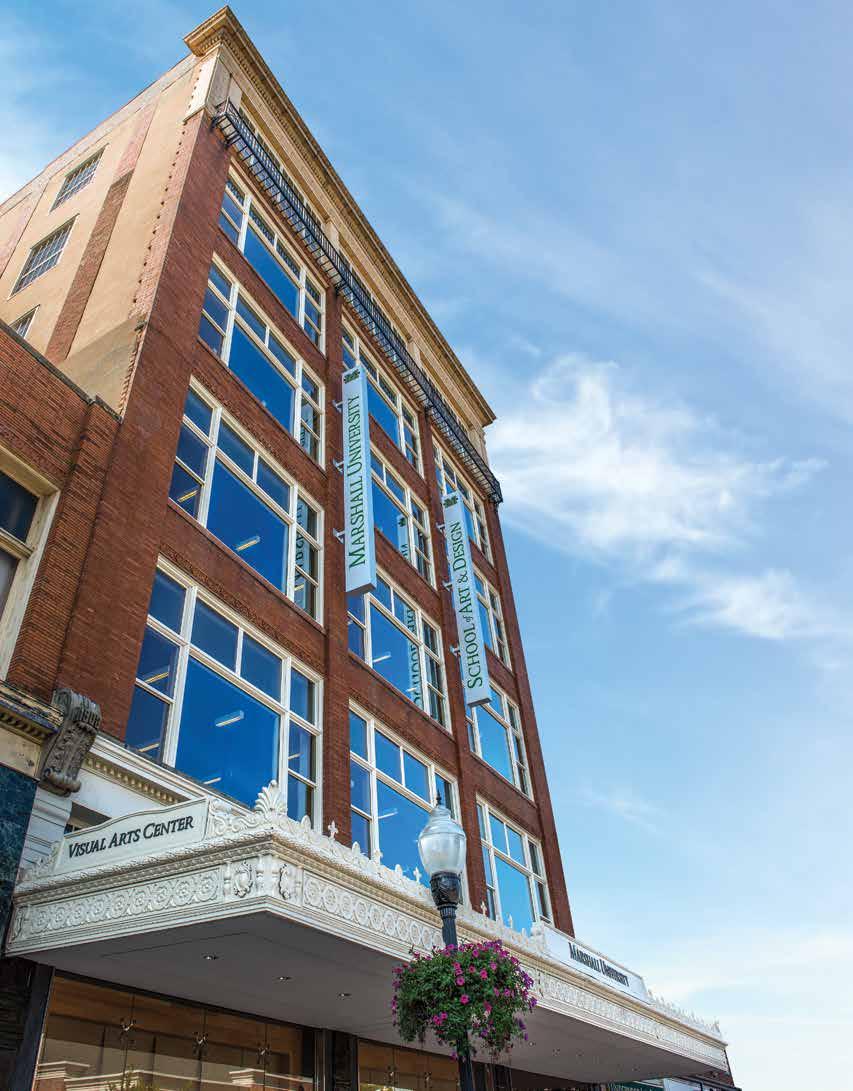
Though much has changed in Huntington’s 150-year history, Marshall’s unwavering commitment to the city remains and is evident in the university’s growth and development initiatives. The university continues to reach beyond its original campus, drawing an increasing number of people closer to downtown through the preservation of historic buildings and construction of new facilities that house programs for education, the arts, business development and manufacturing. Stephen J. Kopp Hall, home of Marshall’s School of Pharmacy, opened in 2019 at the corner of Charleston Avenue and Hal Greer Boulevard in the Fairfield section of Huntington. The 49,560-square-foot facility is named after Marshall’s 36th president, who oversaw creation of the School of Pharmacy in 2012. Pharmacy students and faculty now have access to a dedicated, state-of-the-art facility with research, instructional, communal and administrative areas just steps away from the Joan C. Edwards School of Medicine and the Forensic Science Center. The convenient location allows for an interdisciplinary, team-based experience in which pharmacy students interact with students in the College of Health Professions and the School of Medicine. While Marshall has developed new, modern facilities like Stephen J. Kopp Hall, it also has worked to preserve and restore existing structures that are important in the city’s history, such as the Keith-Albee Theatre and the former Anderson-Newcomb building, which are both located in the heart of the city’s downtown. The historic Keith-Albee Theatre on Fourth Avenue has been a fixture in the Huntington community since its opening in 1928 and is home to the Marshall Artists Series, which moved most performances there in 1936. The Marshall University
HUNTINGTON & MARSHALL
Changing Huntington’s Skyline
Marshall continues to expand its footprint throughout Huntington with the construction of new facilities and the preservation of historic buildings.

Foundation purchased the land on which the theater sits and the building was donated to the organization in 1999. Seven years later, the foundation donated the theater and property to the Keith-Albee Performing Arts Center, a nonprofit group with the goal to preserve and restore the 1920s theater while providing the latest technology to patrons of the arts.
Today, the Keith-Albee Performing Arts Center

The Brad D. Smith Business Incubator provides a variety of support services to businesss entrepreneurs. It’s located inside the six-story Visual Arts Center building (opposite) that also houses the Marshall School of Art and Design. offers the same nostalgic appeal and interior design as the original theater, with the addition of a state-of-the-art surround sound system, projector and the largest indoor movie screen in the region. The theater was added to the Register of Historical Places in 1986 and is a member of the National Trust for Historic Preservation.
Marshall’s contribution to local arts and the preservation of historic places extends beyond the
By Kimberly Price
Photos by Rick Lee & Thorney Lieberman
Keith-Albee to the former Anderson-Newcomb building, which was built in 1902 and is now home to the university’s Visual Arts Center. The previously vacant six-story building across from Pullman Square received a $13 million transformation in 2014 that aligned with the university’s “green” initiative to save money and resources while promoting clean, renewable energy.
The Visual Arts Center is intrinsically sustainable through the reuse of existing materials and utility infrastructure, thus reducing the demand for production of new materials. The 66,000-square-foot facility incorporates the original hardwood and terrazzo floors paired with new steel, insulation, smart lighting, a highly efficient heating and cooling system, and wireless internet. Students have access to a large art gallery and classrooms equipped with the latest tools for photography, mixed media art, videography, printmaking, drawing, screen printing and weaving.
The downtown location allows students and faculty in the School of Art and Design to walk or bike from the Huntington campus. An added bonus is a bevy of restaurants, shopping and other services which reduces the need for automobile transportation and lowers pollution.
The Visual Arts Center building is also home to the Brad D. Smith Business Incubator, which provides support services to entrepreneurs, helping them achieve critical milestones and grow their businesses into sustainable companies. The program gives new business owners access to expert guidance through collaboration with the the university’s Lewis College of Business, the Brad D. Smith Schools of Business, the Innovating for Impact Center for Entrepreneurship and Business Education (or iCenter) and the Robert C. Byrd Institute for Advanced Flexible Manufacturing.
The business incubator affords entrepreneurs the opportunity to network and learn from other incubator companies, attend workshops and seminars, use office and conference room spaces, and access equipment needed to run their businesses. The iCenter’s Entrepreneurs in Residence are also available to help coach the companies and provide expertise in social entrepreneurship and business. Marshall has a long history of providing local businesses with the tools they need to grow and be successful. The university opened its Robert C. Byrd Institute for Advanced Flexible Manufacturing (RCBI) in 1989 as a “factory of the future” to give small- and medium-sized companies access to the latest technology that would otherwise be unavailable to them. Located on the corner of Fourth Avenue and 11th Street, the institute has since adapted and advanced along with the manufacturing industry and is now the only center of its type in West Virginia. RCBI’s Design Works Lab gives innovators and entrepreneurs access to the latest software and equipment needed to design products and bring them to life through
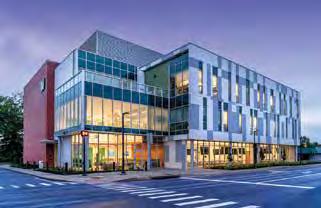
Marshall’s School of Pharmacy opened in 2019 as a dedicated, state-of-the-art facility for pharmacy students and faculty. The Brad D. Smith Business and Innovation Center will attract world-class faculty and the best students who, together, can innovate and grow successful businesses in the community.


Marshall University’s Joan C. Edwards School of Medicine is a statesupported, community-based medical school established in 1977.
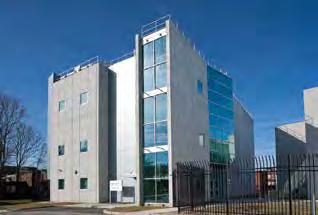
The Marshall University Forensic Science Center is a nationally recognized leader in forensic science eduction dedicated to providing the highest quality forensic analysis services and training.
Built in 1928, the Keith-Albee Performing Arts Center is often home to Marshall Artists Series events. The university opened its Robert C. Byrd Institute for Advanced Flexible Manufacturing (RCBI) in 1989 as a “factory of the future.”
additive manufacturing, better known as 3D printing. The institute is a national Center of Excellence for composite materials, providing support to NASA engineers and firsttier Department of Defense suppliers in West Virginia.
The technical staff at RCBI has over 750 years of combined manufacturing experience and is on site to help clients with programming, setup and operation of equipment. These experts offer courses and training to prepare graduates to enter the manufacturing workforce and provide apprenticeship programs to help workers learn new skills. RCBI’s team of specialists builds relationships with manufacturers and companies by visiting them on site and collaborating to identify ways to improve efficiency and diversify the market.
Marshall has big plans to expand its business education and development footprint in Huntington with construction of the Brad D. Smith Center for Business and Innovation, which will be located on Fourth Avenue on the site of the former UpTowner Inn. The university is set to break ground on the state-of-the-art facility in late 2021.
The building, which will house the Lewis College of Business and Brad D. Smith Schools of Business, is made possible by a $25 million gift in 2018 from Marshall alumnus and Intuit Board Executive Chairman Brad Smith and his wife, Alys Smith.
“This gift is allowing the college to create a culture of entrepreneurship and innovation, reimagine its business programs and academic curricula, and build a new stateof-the-art facility,” said Dr. Avinandan “Avi” Mukjherjee, dean of the Lewis College of Business and coordinator of the university’s New Building Task Force. “The Brad D. Smith Business and Innovation Center will provide space for the community to interact with our business faculty, staff and students through its centers in a business-friendly and technologically advanced environment.
“This facility will help attract world-class faculty and the best and brightest students who together can help innovate and grow successful businesses in the community,” he continued.
Though the project is currently in the design phase, plans for the space include modern classrooms, meeting and study areas, outreach centers, a career center, a sales center, faculty offices, presentation rooms, an auditorium and possibly a maker space for innovation.
“The project’s end goal is to provide a seamless and integrative learning environment that offers rich and meaningful engagement among students, faculty, staff and the business community,” Mukherjee said. “It will embody the Marshall ‘family’ culture.”
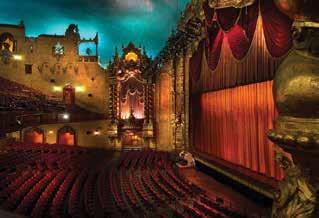
HUNTINGTON & MARSHALL

Kimberly Price is a freelance writer from Proctorville, Ohio.

WISDOMThe of WOODSON
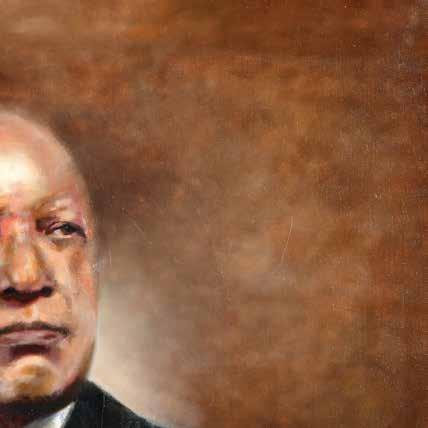
The Dr. Carter G. Woodson Lyceum strives to advance the teachings of the Father of Black History.
By Kaylin R. Staten
Marshall University has a long history of offering leadership throughout the Huntington region. Most recently, the institution’s commitment to diversity and inclusion has been championed by President Jerome Gilbert and other high-ranking school officials. And when it comes to furthering conversations about race, education and other pertinent social issues, one organization in particular is leading the way.
The Dr. Carter G. Woodson Lyceum, housed in Marshall University’s W. Page Pitt School of Journalism and Mass Communications in the College of Arts and Media, does that and more. The name honors the man who founded Black History Month and is acknowledged as the Father of Black History while showcasing the roots the Woodson family laid in Huntington.
Woodson was an educator, historian, scholar and journalist who influenced the trajectory of Black history beginning in the early 20th Century. At its core, the Dr. Carter G. Woodson Lyceum achieves what Woodson aimed to achieve in life: a wide-scale intervention that makes a difference in the lives of individuals and society .
“He was really concerned that Blacks were on the verge of being exterminated because the thought of them was declining,” said Burnis Morris, Carter G. Woodson Professor of Journalism and Mass Communications at Marshall University. “Not many people respected African Americans. That’s why he came along with his intervention. Booker T. Washington had such fears, too. Woodson heard Washington speak for the first time
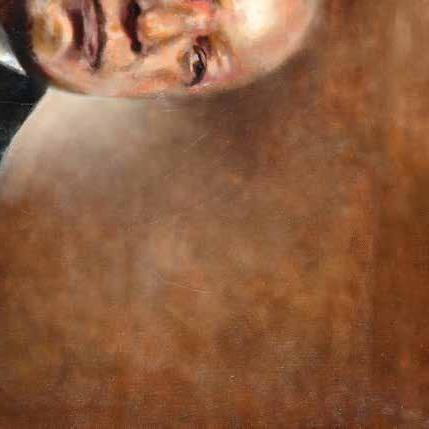
— Burnis Morris,
Carter G. Woodson Professor of Journalism
in 1903, and he heard him express fear that Blacks might be returned to slavery. Those were some of the motivating factors in his life.”
Established in 2016, the lyceum’s mission involves support for education (especially Black history), free speech, a free press, and race and ethnicity issues. In 2011, Morris was named as a Drinko Fellow and began his serious studies of Woodson. In 2015, Morris and Dr. Alan Gould — the late historian and professor who held various roles at Marshall during his 45 years at the school — had a conversation about how to collectively celebrate Black history in our region. In early 2015, 35 people convened to discuss how best for the region to remember Woodson. That meeting produced a long list of ideas, one of which was an institute.
By Molly McClennen
“Dr. Gould thought that the word ‘institute’ came a dime a dozen,” Morris said. “He said that Aristotle’s first school was called a lyceum in 335 BC. The idea was to have a program that serves the region for Black History Month and connects West Virginia and the Tri-State to Carter G. Woodson. His father was one of the first settlers in what became Huntington, and Woodson was principal at the old Douglass School long before he became a well-known scholar and considered the Father of Black History.”
The lyceum features a wide array of educational resources, including a Black History Kit, high school journalism workshop, teachers’ institute, poster contests, and essay contests, and more. The lyceum emphasizes Woodson’s teachings in most events.
“Most people know absolutely nothing about him,” Morris said. “Thousands of people each day drive by his statue on Hal Greer Boulevard and don’t know who he is. It’s a shame because in the first half of the 20th Century, Woodson might have been the best known African American in the world.”
Morris said Woodson wanted to separate activism from research. His overarching vision was to resolve issues to inspire a better educated world.
“He would say that his most important contribution would be Negro History Week, which became Black History Month,” Morris said. “But, his program was broader than that. He didn’t simply want a class being taught on Black history. He wanted the study of African Americans. There are courses on British and European history, but until Woodson came along, there was very little on African American and Black history.”
June 19-23, the lyceum will host the fourth Black History Institute with funding from the West Virginia Humanities Council. The institutes have been funded by major grants from West Virginia Humanities Council, and the funding covers tuition and provides each teacher a $500 stipend. Teachers may contact Morris at morrisb@marshall.edu or complete the application at https:// marshall.az1.qualtrics.com/jfe/ form/SV_1FTTHmaZiBcSW2O.
“I think we’re making a great impact on the teachers who attend,” Morris said. “You can’t teach every teacher in the state, but you do want the 100 or so who attend to take the information back to their peers. The toolkit on our website will be a
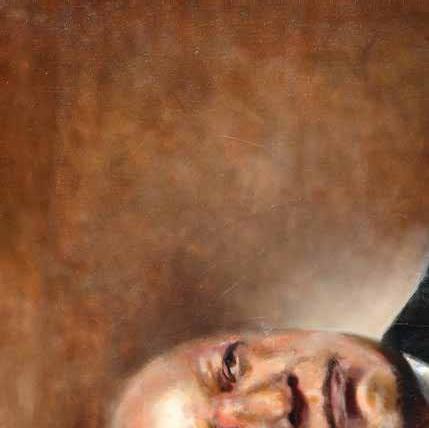
resource for any teacher who wants to look at lesson plans and build programs for their classes.”
To kick off Black History Month this year, the lyceum unveiled a new portrait of Woodson painted by artist Sassa Wilkes. In addition, they released the winners of the Cabell County Schools and Marshall University poster contest, as well as several documentaries commemorating Woodson and Black history. Essay contest winners will be announced later, and more programming will continue to tell Woodson’s and Black history narratives.
In addition, Morris is co-author of Radical Roots, Public History and Social Justice, having contributed a chapter centered on Woodson and a century of making Black Lives Matter.
“When he began more than a century ago, few people believed that Blacks had much history worth recognizing,” Morris said. “Long before there was a Black Lives Matter, Woodson was saying that life should be remembered. He believed in education in which each group recognizes the contributions of others. Because they have been well educated, they would lessen the tensions and have an appreciation for what other people have accomplished.”
To learn more about the Dr. Carter G. Woodson Lyceum and to contribute to the Maple Grove Society, visit www.marshall.edu/ woodsonlyceum.
Kaylin R. Staten is a business owner, public relations practitioner and writer based in Huntington, West Virginia.
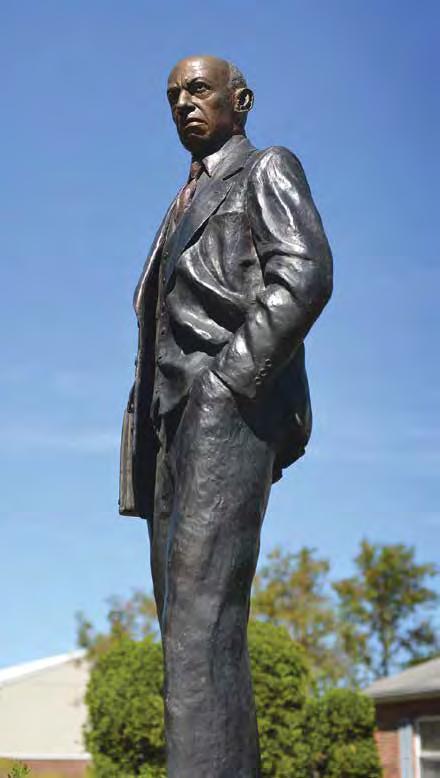
Dedicated in 1995, a statue of Carter G. Woodson is located on Hal Greer Boulevard in Huntington. The statue’s creator, James Lykins, of Elkview, West Virginia, didn’t know who Woodson was until he entered the competition to sculpt his likeness. “At first, it was just a job,” he said. “Then, I got into the character. He’s an inspiration.”
PHOTO BY RICK LEE.
The 50th Anniversary
Marshall officials worked around a global pandemic to plan a moving ceremony that marked the 50th anniversary of the plane crash. By Carter Taylor Seaton
Photos by Austin O’Connor
When the planning committee for the November 14, 2020 Marshall Memorial fountain ceremony began its brainstorming in mid-January, the members knew this year’s event would have to be different. After all, it was the 50th anniversary of the tragic plane crash that took the lives of 75 members of the Herd family. The committee didn’t know just how different it would turn out to be.
When the pandemic hit, all their good ideas went out the window and they formulated Plans A, B, C and D, never thinking they’d have to resort to Plan D. Based on the early reports, they believed the health crisis would be over well before November when the ceremony is traditionally held. According to Ginny Painter, Marshall’s senior vice president for communications and marketing, there was never a mention of cancelling it, however. “We had to look at what we could pull off that would work,” Painter said. “We ended up with three keystone events.”
The first event, on Tuesday of anniversary week, was the rededication of the Marshall Football Memorial. The abstract pipe-sculpture depicting a kneeling football player, which had sat for years in front of the Phi Kappa Alpha fraternity house, had badly deteriorated over the years. However, the family of its creator, Vernon Howell, had mounted a fund-raising campaign to have it refurbished. Now relocated to campus, it rests within sight of the Joan C. Edwards Stadium. President Jerome Gilbert, Howell, his daughter, and John Bodo, the 1970s fraternity member who designed the sculpture, spoke to the socially distanced crowd.
On Friday, Nov. 13, President Gilbert did something he’d wanted to do for some time — award posthumous degrees to each of the students who perished in the plane crash. Family members and members of the Marshall family accepted diplomas for the 39 students (37 football players, a student assistant, and a Parthenon reporter) that were lost. “It was a very moving event,” Painter noted.
The next morning the Huntington campus was a beehive of activity. Because the football game between Marshall and Middle Tennessee State was scheduled for an afternoon kickoff, the ceremony had been moved to 9 am. It was cold and spitting snow on the fountain plaza and on

Buskirk Field, where chairs had been placed to comply “They even joined members of the Marshall family in with COVID-19 standards. Large screens were also erected placing the traditional white roses on the fountain ledge to provide all attendees viewing access. These weren’t the as the water was turned off.” only adaptations the committee had been forced to make. Since the ceremony began in 1972, current football “As we got closer, we kept hav- players have placed flowers, ing to scale it back and back, but this year, they were both until finally the in-person restricted by COVID protoevents were for family mem- cols and busy getting ready bers only,” Painter explained. for their afternoon kickoff. “However, the ceremony was Following the ceremony, also livestreamed so everyone family members strolled the in the Marshall family could campus to see large banners watch the milestone event.” displaying the faces and
Music, both live and pre- names of each person killed recorded, was a big part of this in the crash — an idea that special ceremony. Well-known was proposed at a planning contemporary Christian committee meeting. “The singer-songwriter and Kenova, banners we erected of the 75 West Virginia native, Michael souls lost in the plane crash W. Smith, returned to campus got more attention and made to perform. The Marshall University Chorus and the “The banners we erected of the people much more emotional than we ever anticipated,” Chamber Choir provided the 75 souls lost in the plane crash Painter noted. The banaccompaniment to a video ners will remain on campus featuring Herd family mem- got more attention and made through the spring semester. bers, student body officials, Huntington Mayor Steve people much more emotional Commemorative lapel pins, featuring the outline of the Williams and former Coach Red Dawson. “Everything was than we ever anticipated.” fountain, the words, “Never forget” and “50 Years,” were produced by our students and — Ginny Painter, also created as gifts for the faculty especially for this oc- senior vice president for family members. casion. It was really special,” communications and marketing Despite the need to resort Painter said. to Plan D, the fountain cer-
Lucianne Kautz Call, the daughter of Marshall Athletic emony and the other anniversary events were as moving Director Charles Kautz, who perished in the crash, was and memorable as the committee hoped they would be. the keynote speaker. Call was the representative of the Plus, Marshall won the game, 42-14. victims’ families on the planning committee for the 50th “Everyone I talked to came away feeling grateful that anniversary ceremony. “I am deeply honored to have been we didn’t let the pandemic prevent us from marking this chosen to represent the 75 families who lost a loved one very important ceremony,” Painter said. “And the most on Nov. 14, 1970,” said Call. “Those souls will live on in gratifying aspect of the day was that the family members the Kelly-green hearts of the football players recruited to were appreciative. After all, that’s the whole point – to play for the Thundering Herd for generations to come.” commemorate those who died 50 years ago and to show
As the gathered families listened to the speakers, lighted the families that we will never forget.” candles and floral bouquets floated lazily in the waters of If you want to see the all the events of anniversary the fountain. Among the sea of green-clad guests, a few week, they are available at marshall.edu/neverforget. purple jackets could be spotted. Members of the 1970 East Carolina football team who had played against Marshall on that fateful day had come to pay tribute to their long- Carter Taylor Seaton is a freelance writer living in gone opponents. Huntington. She graduated from Marshall University in
“They came up here with very little notice and very little 1982. She has written several books including the novels fanfare, but it was incredibly moving,” Painter remarked. Father’s Troubles; amo, amas, amat and The Other Morgans.

World Class
Meet five student-athletes from around the world who are suiting up for the Thundering Herd.
By Keith Morehouse

It’s sometimes said that college is where you begin to get a more worldly view of life. That’s especially true on the tennis court, basketball court, swimming pool, soccer pitch, track and more at Marshall. Today, there are more than three dozen international student-athletes at Marshall from 21 different countries.
Recruiting student-athletes from overseas isn’t easy. Many of them have “agents” who help them find colleges in the United States that fit their needs. They then contact coaches and begin to establish a relationship. If their talent meshes with what the Herd coaches need, then they attempt to make the geography match.
Passports and scholarships have transported these five athletes from different parts around the globe to the Marshall University campus in Huntington, West Virginia. Here are their stories:
Jutte Van Hansweyck
(You-ta Vahn Hans-awick)
There are lots of good tennis players whose parents hand them a racket when they’re old enough to walk, and that racket becomes a steady companion for years to come. But it took a while for Jutte Van Hansewyck, a native of Belgium, to grab a hold of tennis and hang on.
“I actually did gymnastics from three to 12-years-old,” Van Hansweyck said. “I didn’t play tennis at that point but when I was 12, I quit gymnastics because it was too much. Then I went into track because my older sister was doing it. I was a pole-vaulter. Then I started playing tennis when I was 14. Game, set and match — tennis had won over the multi-sport athlete. Van Hansewyck now appreciates the game more than ever. Because of COVID-19 and the delays in the college season, there was an 11-month gap between competitive matches for the Marshall women’s team. The 2021 season opener against Kentucky made that old saying “absence makes the heart grow fonder” really hit home. “I was enjoying just playing,” Van Hansewyck said. “Not really even just focusing on winning, but just being out there and playing with the team. It reminded me how much I like it.”
She won 22 matches in singles and doubles in her freshman season. That athletic career choice at 14 years old seems to have served her well. Advantage, Marshall.


Obinna Anochili-Killen
(O-Beana An-o-chili Kill-en)
Once upon a time there was big man from Lagos, Nigeria, who came to the United States to make a name for himself in basketball. His name may ring a bell — Hakeem Olajuwon, considered one of the greatest NBA centers of all time.
Marshall freshman Obinna Anochili-Killen would love to follow Olajuwon’s path.
“Over there every kid in Nigeria thinks that when you go to the United States you go right to the NBA,” Anochili-Killen said.
But basketball was an afterthought to him growing up in Lagos. “I was a goalie in soccer,” AnochiliKillen said. “When you are in other countries apart from the United States, you’re always good at soccer because that’s all we played. I was a huge soccer fan and I was good at it. But when I grew taller I started to pursue basketball. I used to be a fan of pro soccer players like Lionel Messi. I transitioned into basketball and then it was Michael Jordan.”

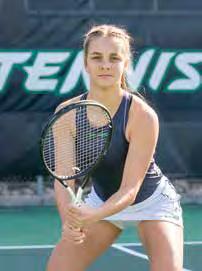
The 6-foot-8-inch Anochili-Killen is just one year removed from his All-State career at Chapmanville Regional High School. His learning curve has been steep. He’s started every game but one for Marshall.
“It’s every kid’s dream to take it to the next level in basketball or in school,” Anochili-Killen said. “If God says you’re going to the NBA or you’re going to play overseas, I’ll do that. If God says you’re going to be an engineer or a doctor, I’m good for that. I just want to make a good living.”
Maybe the software engineering major is falling back on his old soccer knowledge. After all, two goals are better than one.
Eszter Laban
(Ester La-bohn)
Eszter Laban confesses to becoming somewhat obsessed with a certain American delicacy since she
left Budapest, Hungary, for life in the United States. She’s developed an affinity for pecan pie. Calories probably aren’t a concern for Eszter; not when you swim the 400-meter individual medley.
That’s a discipline that requires swimmers to master the four strokes of the sport — freestyle, butterfly, backstroke and breaststroke — all in one race.
“You can’t really predict what will happen in the 400 IM,” Laban said. “It’s long and you have to focus because it combines the four strokes. You have to be thinking about your next leg while still concentrating.”
— Eszter Laban, Hungary
Milo Yosef
(Mile-o Yo-sef)
It will go down as one of the most iconic moments in Marshall soccer history. It was the 43rd minute of Marshall’s NCAA Tournament game against West Virginia University and Jonas Westmeyer sent in a corner kick that Milo Yosef headed into the backright corner of the net. The native of Germany then broke into a dead sprint toward the home bench to celebrate. The goal gave the Thundering Herd a 2-1 lead and it held up for the Herd’s first win ever in the NCAA Tournament.
“It was a proud feeling,” Yosef said about that historic 2019 NCAA
tournament run and a No. 11 final national ranking. “Marshall wasn’t really known for soccer and 2019 kind of put us on the map.”


Leaving her family halfway across the world isn’t easy, but Laban said it’s all part of the maturation process, in sport and in her life.
“Honestly, I like to be on campus,” she explained. “I enjoy the freedom and the challenge of being away from my family. I’m experiencing how to live on my own.”
That doesn’t mean she doesn’t miss them. She was able to go home for Christmas. Marshall’s match with Ohio University in January was streamed and her family got to watch her on Facebook as she placed 2nd in the 400 IM and the 200-yard butterfly. Life in the States, along with the pie, has been good to her so far.
ADAM GUE/MARSHALL ATHLETICS
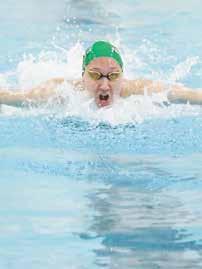


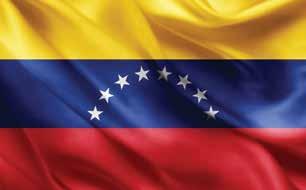
Maybe a globe would be a more apropos. This Marshall soccer team roster reflects the world-wide appeal of a sport that superstar Pele once called “the beautiful game.” The roster is replete with players from New Zealand to India, from Ghana to Germany. Yosef said he appreciates the international tapestry that makes up this Marshall program.
“They’re like a second family,” he said of his worldly teammates. “I’m proud of it. I’ll have places to visit when I’m finished here.” in track and field when she was 9 years Parra-Vargas has used sport to
Yosef — like the Herd — burst old, largely because her parents were travel the world. She competed in onto the scene in 2019. He was the athletes. She learned to love compet- the under-18 world championships Conference USA freshman of the in Nairobi, Kenya, year, a United Soccer Coaches All- in 2017, and said that American, and the league leader in it is the most memopoints and goals. Already he’s been rable place she has tabbed as the Conference USA pre- ever visited. season Offensive Player of the Year. Being away He appreciates the attention, but from home can be he’ll tell you soccer is the ultimate difficult for any colteam game. lege student, espe-
“If one person’s not running, the cially when home whole team’s not running,” Yosef said. is 2,000 miles “If I didn’t like team sports, I would away. Parra-Vargas play tennis.” says she misses her
He jokingly family and friends said his least favorite part of “I found Marshall to be but enjoys the culture change in his sport is run- the best option for me Huntington. ning. He must not have been since the university meets “The most interesting part is thinking about all my expectations in the people,” Parrathe celebratory sprint in that academics and athletics.” Vargas said. “Most of the people are NCAA tourna- — Maria Parra-Vargas, ing because of kind to me and they are always giving ment win. That Venezuela them. She came you a hand when you need it.” was impressive. to the United States to attend Maria Parra-Vargas school in Florida and found her way (Ma-ree-a Par-a Var-gus) to West Virginia through someone
Maria Parra-Vargas’ travels across she respected. the world involve a hop, a skip and a “I heard about Marshall from my jump — well, lots of jumps. The fresh- coach,” Parra-Vargas said. “We set man specializes in the long jump and up a visit and I found Marshall to high jump in Marshall’s track and field be the best option for me since the program. The native of Barquisemeto, university meets all my expectations Lara, in Venezuela became interested in academics and athletics.” Keith Morehouse is the sports director at WSAZ NewsChannel 3 in Huntington. He is a 1983 graduate of Marshall University where he earned a B.A. in broadcast journalism. He is a two-time Emmy winner and five-time West Virginia Sportscaster of the Year. In 2019 he was inducted into the W. Page Pitt School of Journalism Hall of Fame.

Huff’s Herd
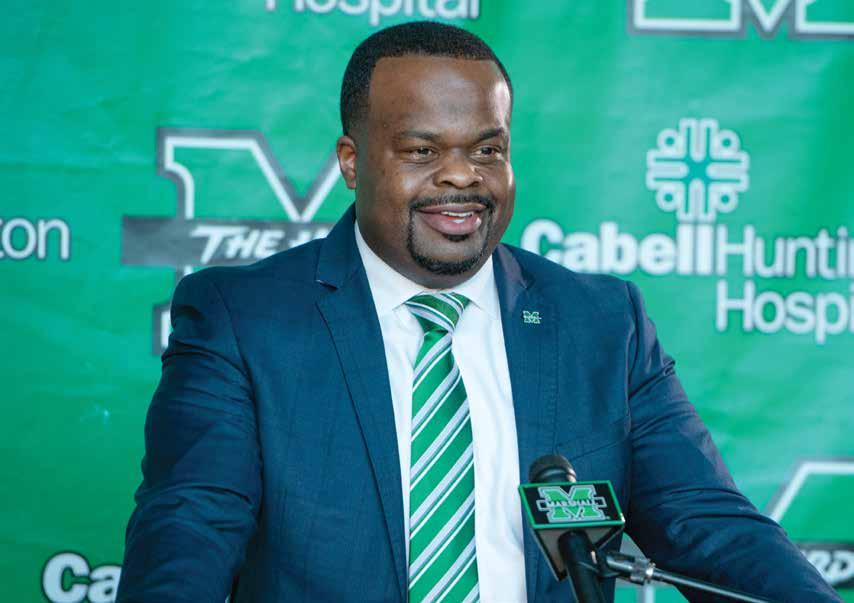
An understudy of coaching legend Nick Saban stands ready to run with the Herd.
By Keith Morehouse
It’s nearly 600 miles from Tuscaloosa, Alabama, to Huntington, West Virginia, and even by air it’s not an easy trip. On Monday, Jan. 18, Charles Huff’s plane touched down at Yeager Airport in Charleston. It was just past 9 p.m., but his day wasn’t finished yet.
Huff wanted to stop by the “office” before he called it a day, and so he and his Herd entourage detoured to Joan C. Edwards Stadium. Marshall’s 31st head football coach walked the turf and surveyed the surroundings, like a proud new homeowner. At his introductory news conference the next day, the significance of his walkthrough kicked in.
“Walking the field last night, I could feel the emotion and the energy; I could hear the crowd and there was
nobody there,” Huff said as his voice started to quiver. “I’m a strong believer that you’ve got to have a vision before it becomes real. And the vision I had when I was a 5-year-old kid about leading a football program became real last night. A lot of hard work went into it. A lot of people took a chance on me and I’m gonna make sure those people don’t regret it.”
Marshall President Jerry Gilbert and Athletics Director Mike Hamrick have taken a chance giving Huff his first head coaching job. It wasn’t lost on either of them that Huff celebrated a national championship with Alabama the Monday before he arrived in West Virginia. They also know Marshall has authored a pretty good football story of its own.
“All of the faithful know Herd football is about greatness and success,” President Gilbert said. “It’s about tragedy and rebirth, it’s about the 75 and the Young Thundering Herd. In the end we chose a man of football success, a man of boundless energy, a man of humble beginnings.”
Huff knows that “75” subject well, and he’s about to take a master’s class in what the Herd football history means around the university and around Huntington.
“The 75 is a story that every college football fan, player and supporter knows about. They understand what happened on Nov. 14, 1970, and they have a place in their heart for Marshall,” Huff said. “For me to be able to be a part of the rebirth, and continue that rebirth ... I can’t tell you how appreciative I am for this opportunity.”
The 37-year-old has had coaching stints at Vanderbilt, Penn State, Mississippi State, the Buffalo Bills and most recently the Crimson Tide, where he was the running backs coach under Nick Saban. With seven national championships, Saban’s generally regarded as the best college football coach in history. That’s saying something when you work close to Paul “Bear” Bryant’s statue. Saban, from Fairmont, West Virginia, had some parting words for Huff.
“The one thing he told me in our discussions before I left was that West Virginia is a very proud state, and that Marshall is a very proud university,” Huff relayed. “He then told me, ‘If you go there and it’s done right, you’ll never want to leave.’ When I looked at the coaches that have been here before me, their track record echoes that sentiment. Coaches don’t come here to leave. They come here and 10 years later they’ve had success. Coach Saban really gave me insights on how you can fall in love with a community and how it can embrace you.”
His to-do list while in Huntington has kept him hopping — the introductory news conference, player and coach meetings, media responsibilities. He even wedged in an appearance on national radio on the Jim Rome show. “There may be better-looking head coaches, there may be older head coaches, but I can promise you one thing — that I and my coaching staff will not be outworked,” Huff asserted.
Athletics Director Hamrick knows coaching hires are like recruiting classes. You don’t evaluate them until later. But he feels strongly that Huff is ready to run with the Herd.
“Of all the people that we spoke with about Coach Huff, they had nothing but good things to say about him,” Hamrick said. “You look back when you hire coaches — where they’ve been, who they’ve worked for, what types of programs have they been in, and he checks all the boxes.”
Lots of coaches can “win” the news conference, but Huff knows he’ll be judged by what his Herd teams do on the field, and how players grow and mature on and off the field. Some legendary Herd players who have come before him are on board.
“I truly believe our former player community is energized and excited for Coach Huff and the Marshall family,” said Thundering Herd Hall of Famer and former NFL star Chad Pennington said. “Many of us see his hiring as essential to elevating our program in multiple areas, from the locker room to the university to the state and the nation.”
“I’m extremely excited for Coach Huff and his family, and looking forward to him joining the Herd,” said another Marshall Hall of Famer Doug Chapman. “He’s had success everywhere he’s been and will be great for Marshall and the city of Huntington.”
That work ethic and commitment Huff talks about is the same template he wants to see between the lines from his teams.
“We’re going to be fast, physical and aggressive,” Huff stated. “We want other teams to say at the end of the game, ‘I hate playing that team. Don’t put them on the schedule again.’ I want our teams to play with an intensity that other teams simply can’t match.”
Just like that first day in West Virginia, Huff knows the days will be long. But that’s what he’s worked for his entire life. It’s why he was up early in Huntington, grabbing coffee with boosters at The Market and at Grindstone. The caffeine helps him start his day. Just make sure it’s served in a to-go cup. Coach Charles Huff has work to do.
Keith Morehouse is the sports director at WSAZ NewsChannel 3 in Huntington. He is a 1983 graduate of Marshall University where he earned a B.A. in broadcast journalism. He is a two-time Emmy winner and five-time West Virginia Sportscaster of the Year. In 2019 he was inducted into the W. Page Pitt School of Journalism Hall of Fame.
Marshall graduates studied psychology, biology know their fellow and French. She says living in alumni have made Morocco has been a challenga mark not only on the state of ing, yet thrilling, experience. West Virginia, but in every state Her time at Marshall helped in the U.S. But they may not be her prepare for the adventure. as aware that Marshall’s reach “Studying French was imextends throughout the world, mensely helpful,” she says. “It with graduates living and find- is widely spoken here. Also, ing success in many different through the Yeager Scholar procountries. Four Marshall alumni gram, I had the opportunity to currently living abroad credit study abroad. Having previously Marshall for preparing them While living in Morocco, Brianne Erwin has been able experienced negotiating new not only for their careers, but to visit a variety of locations. Shown here in the Anima cities and countries, I felt better for the adventure of building a Garden in Marrakesh, Atlas Mountains in the distance. prepared to live internationally.” life far from Huntington. Erwin says the people of Delbarton, West Virginia native works as the housing coordinator for Morocco are genuinely welcoming Brianne Erwin (’03) lives with her the U.S. Embassy. In this role, she is and kind, making the experience of family in Rabat, Morocco, where her part of a team that helps incoming living abroad enjoyable. She describes husband is a diplomat with the U.S. families secure housing in Morocco. Morocco as a wonderful place to live. Department of State and where she Erwin was a Yeager Scholar who “Being this far away from family
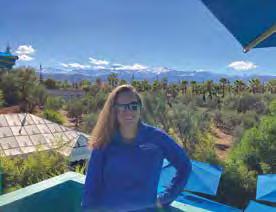
ALUMNI

and ‘home’ is difficult on occasion. I miss the ease of communicating in my native language and being in familiar surroundings. But I am thankful for the opportunity to live abroad and serve my country,” she says.
Jocelyn Eikenburg grew up outside Cleveland, Ohio and attended Marshall as a Yeager Scholar, graduating summa cum laude in 1999 with a major in environmental biology and minors in chemistry and Spanish. For a total of 12 years, Eikenburg has lived in China, where she now works in Beijing as an editor for the China Daily website.
Eikenburg studied at the University of Granada in Spain for a semester while at Marshall. She returned to the U.S. with a desire to live abroad, but did not expect to end up living in China until she learned about Marshall’s Appalachians Abroad
Jocelyn Eikenberg enjoys time in Ningxia, a province in northwest China. The Hui people, one of the 56 officially recognized nationalities of China, live here. program, which sends graduates to teach English there. “None of my undergraduate education, including language study, had prepared me for China,” says Eikenburg.
“But I decided to sign on for a year, thinking it would just be a
‘gap year’ or a chance to travel for a short time while working.
Well, one year in China led to many more, as I discovered a passion for Chinese culture and language, and also found job opportunities that allowed me to write. I feel fortunate to have built a wonderful life for myself in this country.”
In addition to providing her the opportunity to become fluent in Chinese, Eikenburg says living in

ABROAD

Meet four alumni working in countries across the globe.
By Molly McClennen
China has given her the opportunity to gain a global perspective.
“Residing abroad, especially in a country where your native language is not widely spoken, is a humbling experience. It helps you understand on a daily basis that the milieu in which you grew up isn’t necessarily universal — that people in other parts of the world speak and live in different ways. If everyone in the world could have the chance to set foot in a foreign country for just a small period of time, even a few hours, it would go a long way toward facilitating more mutual understanding around the globe, leading to a more peaceful earth for all,” she says.
Tyler Webb (’17), who grew up in Lavalette, West Virginia, tried several majors before realizing she was meant to be an English major. Today, Webb lives in Pyeongtaek, South Korea, about an hour south of Seoul, where she works on Camp Humphreys Army Base as a Department of Defense contractor for TRICARE. After graduating from Marshall, Webb knew she wanted to pursue a master’s degree. She had studied abroad and decided to return overseas for graduate work. Webb graduated from Yonsei University in Seoul, known as the “Harvard of Korea,” in August 2020 with a master’s degree in English language and literature. She then moved to Pyeongtaek to be closer to her boyfriend at the time, whom she has since married.
Despite missing Huntington icons like Jim's Spaghetti, Black Sheep Burrito and Brews, and Paula Vega's Cupcakes, Webb loves the opportunity she has had to learn about South Korea.
“One of the best parts of living overseas is immersing yourself in the culture of the country that you are living in,” she says. “The locals are always excited when they see someone foreign attempting to understand aspects of their culture.”
Webb says she hopes students will realize how fortunate they are to be attending Marshall.
“I did not realize how special Marshall University was until I went to graduate school in a foreign country,” she says. “The professors at Marshall are truly one of a kind and care for their students in and out of the classroom. I really miss that type of learning environment, so students should take advantage of it while they are there!”
One of the places Tyler Webb has toured while living in South Korea is Gwanghwamun Palace. There are outfit rentals available nearby the palace and the surrounding grounds are filled with historically-dressed visitors posing for pictures.
Pete Collman
(’96) moved from his hometown of Falls Church, Virginia, to attend Marshall because of its outstanding program in radio and TV journalism. After graduating, he built a career in public relations in Atlanta until the desire to be close to his children led him to “If everyone in the world could have the chance to set foot in a foreign country, it would go a long way toward facilitating more mutual understanding around the globe, leading to a more peaceful earth for all.”
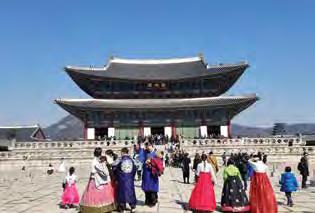
— Jocelyn Eikenburg, China
relocate to Prague, Czech Republic. He has lived there since 2011.
Collman works as a senior technical mainframe writer for Broadcom Inc., but he also engages in a variety of creative projects inspired by his travels and living abroad, including publishing a book on Czech traditions (Curious Czech Christmas) and publishing photographs of his travels at www.collmanphotography. com. But his passion projects are his podcasts and YouTube channel: Past Access. In these podcasts and videos, Collman, a wheelchair user, reports on culture, history and his experiences with wheelchair accessibility as he travels. Collman served as an alternate for the 2000 Paralympics wheelchair fencing team, which gave him the opportunity to travel extensively. He hopes to share the confidence he developed through that experience with other people with disabilities.
“I never would have thought I would have the courage or know-how to travel internationally as a wheelchair user. I want to be able to take away that fear of travel some people with disabilities have. I want to let them know they can do it,” he says.
Collman’s YouTube channel can
— Tyler Webb, South Korea
be viewed at www.youtube.com/channel/UCXQKBE0TD34qtifjeemA_5g and the Past Access website is www. pastaccess.com.
Marshall remains dear to Collman’s heart. He recently shared the story of his alma mater with the world when he produced a podcast episode on the 50th anniversary of the Marshall plane crash, which is among his most downloaded episodes of all time.
Collman says he hopes other graduates will follow in the footsteps of their globetrotting fellow alumni and be open to the adventures and possibilities of living abroad.
“I tried to map out my life and it took so many different forks to get me where I am,” says Collman. “But I would not change it for a thing. I would tell a graduating student to keep the possibilities open, or you may miss some wonderful things.”
Currently living in Prague, Czech Republic, Peter Collman, a wheelchair user, reports on culture, history and his experiences with wheelchair accessibility as he travels. Molly McClennen is a freelance writer living in Huntington, West Virginia.
